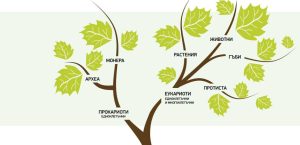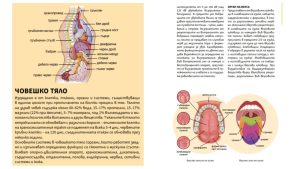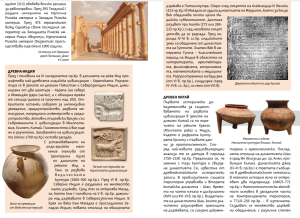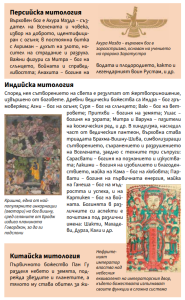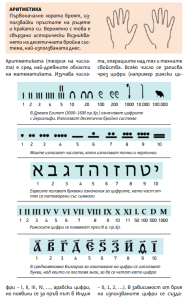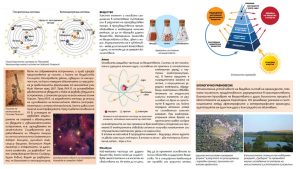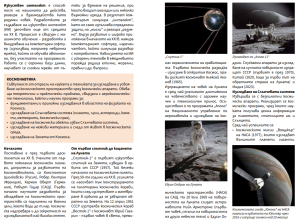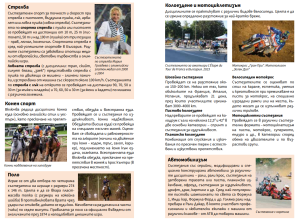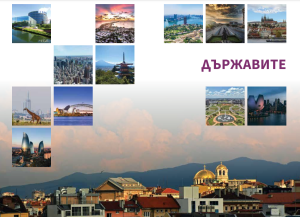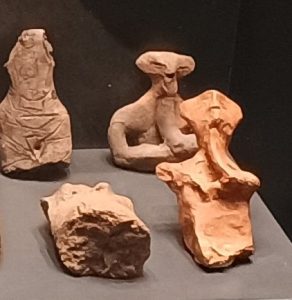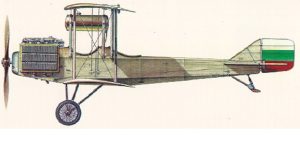“The world. A concise encyclopedia” introduces universal encyclopedic knowledge about man and the world around him in a synthesised and comprehensible format. Scientific data is arranged in seven main topics – “The Universe”, “Earth”, “Plants and Animal Life”, “Man”, “Society”, “Countries” and “Bulgaria”, which are developed in 977 articles. Each includes subtopics with independent articles about man and nature, history, the arts and literature, science, technology and technique, sports, and countries of the world. 128 pages of a total of 687 are dedicated to Bulgaria.
The information is also supplemented with chronologies of important discoveries in physics, technology, medicine, construction and architecture, visual arts and music, world literature, and the most influential political figures and events in XIX-XXI centuries. Authors, contributors, reviewers and consultants are leading scientists and specialists from the BAS, Sofia University “St. Kliment Ohridski”, Technical University – Sofia, Military Academy “G. S. Rakovski”, etc. The editing process was completed on September 25, 2024. 1889 photographs, drawings, graphs, tables, and maps are added to the articles.
THE UNIVERSE
The “Universe” topic presents a substantial portion of the knowledge about galaxies, stars, the Solar System and other atronomical objects.
You will learn that:
|
EARTH
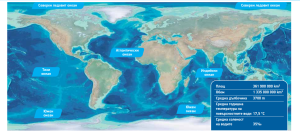 The “Earth” topic introduces knowledge about the construction of our planet from the core to the upper layers of the atmosphere and its relief, continents geography, the World Ocean, and most common atmospheric phenomena.
The “Earth” topic introduces knowledge about the construction of our planet from the core to the upper layers of the atmosphere and its relief, continents geography, the World Ocean, and most common atmospheric phenomena.
|
You will learn that:
|
PLANTS AND ANIMAL LIFE
Organism classification based on evolutionary theory and biological sciences are defined in the “Plants and Animal Life” topic. It demonstrates the structure of living organisms and their ecological role.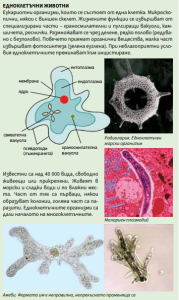
|
You will learn that:
|
MAN
The “Man” subject provides basic knowledge about human organism’s structure and functions by examining main systems in the human body (organs that work together and perform certain functions). Socially significant diseases and the risk factors for their development are briefly presented.
|
You will learn that:
|
SOCIETY
It includes a chronological overview of human history from 40,000 years ago, when the modern man appeared, and traces the main processes, events, personalities and ideas from Stone Age to modern times.
|
You will learn that:
|
Main mythological deities, cultural heroes and myths about the origin of the world, natural phenomena and humanity in the ideas of different peoples in antiquity are described.
|
You will learn that:
|
A brief overview of the world’s most widespread religions is given – what are their sacred texts and symbols, their beliefs and practices.
|
You will learn that:
|
The encyclopedia explains basic concepts in the fields of mathematics, mechanics, physics, astronomy, geophysics, meteorology and climatology, chemistry, biology, and ecology. Modern discoveries and advances in physics, such as the discovery of graphene in 2004, the Higgs boson (the so-called ‘God particle’) in 2012, and the first direct observation of gravitational waves in 2015 by LIGO scientists are included.
|
You will learn that:
|
The development of main technical sciences and directions – automatics, cybernetics and robotics, electrical engineering and electronics, energy, information and communication technologies, computer sciences, cosmonautics, materials science, machines and mechanical engineering, transport, is examined.
|
You will learn that:
|
Chronologically, the history, styles and trends and achievements of construction (one of the oldest human activities) and architecture are examined.
|
You will learn that:
|
The creative skills of man are represented – fine arts, photography, music, ballet, theatre and cinema. Their development is traced in short chronologies.
|
You will learn that:
|
The most significant works of world literature are examined chronologically – from ancient mythological and religious texts, through the notable monuments of world’s classics, to the latest works reflecting the social problems of our time.
|
You will learn that:
|
The publication introduces readers to the basic rules and criteria of more than 60 types of sports, most of which are included in the Olympic Games. The years and venues of modern Olympics since 1896, as well as all Bulgarian athletes who won gold medals from the Paris Olympics in 2024 are represented in tables.
|
You will learn that:
|
COUNTRIES
In the “Countries” topic, readers will find statistical data (area, population, official language, currency) and main events in the political development of 197 countries, internationally recognised sovereign states and members of the United Nations.
BULGARIA
The “Bulgaria” topic contains articles that, in a thematic order, introduce the reader to the rich nature and diversity of plant and animal life in Bulgaria, including protected and conserved areas. The country has about 790 endemic animals and 186 plant species.
|
You will learn that:
|
The encyclopedia traces Bulgaria’s thousand-year history – from prehistory, when the Bulgarian lands were an early evidence of human life in Europe, through Roman Empire and Byzantium era, the Middle Ages, and modern times.
|
You will learn that:
|
Bulgaria’s development and achievements in the field of science, technology and innovation are also in focus.
|
You will learn that:
|
Historical stages and cultural influences that shaped the architectural landscape of today’s Bulgaria are included. Bulgarian natural and cultural tangible and intangible world heritage sites are represented.
|
You will learn that:
|
The overview of Bulgarian literary tradition provides information on the earliest Bulgarian written monuments, as well as key authors and works from the main literary schools and movements. The development of genre varieties, periodicals and media in Bulgaria has been traced. Contemporary writers such as Teodora Dimova, Milen Ruskov, Georgi Bardarov, Zdravka Evtimova, Georgi Gospodinov, et al. are included.
|
You will learn that:
|
The development of arts (visual, musical, dance, theatrical, film, circus) has been traced from the first manifestations of creativity in the Bulgarian lands until today.
- In the XIV century Ioan Kukuzel, “The Angelic Voice”, reformed the Byzantine neumatic notation and created a new type of chant that spread in the following centuries in Russia, Ukraine and Belarus as Bulgarian chant;
- The first Bulgarian operas were “The Poor Woman” (1900) by Emanuil Manolov and “Borislav” (1911) by maestro Georgi Atanasov;
- The first professional theatre in our country was created by Frenchmen Bossi and Brun in 1881 in Plovdiv;
- Vasil Gendov was the director and leading actor in the first feature film “A Bulgarian is a Gallant” (1915) and the first sound film “The Rebellion of the Slaves” (1933).
Modern Bulgaria’s administrative-territorial division is presented with statistical and geographical information about districts, a brief history of district centres, information about natural, cultural and tourist sites, using the officially published data from population census conducted in September 2021.
“The world. A concise encyclopedia” provides up-to-date information on the remains of the city of Heraclea Sintica, founded in the middle of the 4th century BC and discovered at the Rupite village, the underground mining museum in Pernik, the well-temple near the village of Garlo, the Demir Baba Tekke shrine, built in the middle of the 16th century on an ancient sacred site, as well as answers to the questions:
- WHERE is Bulgaria’s geographical centre?
- WHICH is the tallest and oldest lighthouse in our country?
- WHICH is the most famous spa resort?
- WHAT is the water temperature of Central Sapareva Banya’s geyser?
- WHICH is the largest paleontological site in the Balkans?
2024, ISBN 9789548104456, 9786191954056


